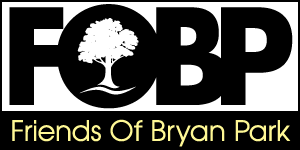BRYAN PARK ACTIVITIES
Family Activities
Families with children are encouraged to visit and explore Bryan Park: its open spaces, active and passive recreation resources, and many natural areas: ponds, streams and wetlands, and trails through the woods.
Bryan Park has picnic areas, benches, and lots of places where you can walk, run and bike. The back parts of the park (beyond the yellow gates) include miles of paved roads and trails where vehicles are prohibited. Enjoy the freedom and quiet of a traffic-free environment!
Bryan Park has a rich abundance of wildlife: birds, small mammals, amphibians, aquatic life, and the occasional snake. Keep your eyes and ears open!
The Park has a wide variety of trees and thick woods.
Nature Preserve, and Nature Center
Bryan Park has a Nature Preserve, west of Shelter # 1, with a Nature Center, where you will see many types of native plants, and many species of pollinator insects, and many species of birds, bugs and reptiles. It is isolated from the rest of the park by the Park’s ponds, the Jordans’ Branch stream valley, and deep woods. It is a peaceful oasis where nature reigns. Please respect the quiet and do not disturb the wildlife. Keep your dog on its leash! Throughout Bryan Park, follow the brown signs to the Nature Center.
The Virginia Master Naturalists (Riverine Chapter)
The Virginia Master Naturalists have been working in the Nature Preserve for years to fill it with native plants, both beautiful and essential for reestablishing the natural balance of feeding, mating and nesting. Most of the garden has interpretive signage, and there is a Nature trail that winds through the woods, the foundation of what we hope will be a self-guided tour of trees and plants in the woods providing and a lesson in the life of the forest life-cycle: growth, competition and cooperation, decay and regeneration.
NOTE NATURE CENTER CLOSED, SUMMER 2019 so Environmental Education Classes are discontinued until further notice.
The Virginia Master Naturalists (Riverine Chapter)
The Virginia Master Naturalists (Riverine Chapter) has been working for years to create an educational and environmental resource adjacent to the Nature Center. In 6-8 garden plots, they have cultivated typical and unusual native plants, with a concentration on pollinator plants, which are critically important to attract, feed, and provide habitat for insects, reptiles, bats and birds. If your eyes are sharp, you may notice the small bird-house structures attached to trees, which are bee hotels.
Most are attracted to showy flowers, but some are…
Note that in the vicinity of the Nature Center and the garden, shrubs and trees have been planted that also attract and sustain a significant number of native birds and insects. In the older trees, hawks and owls are regular residents – they are sometimes hard to spot but you can hear their distinctive calls. Note too, that many of the damaged trees and the standing trunks of the dead trees are retained, for the homes, shelter, bugs and grubs they provide.
The Riverine Chapter of the Virginia Master Naturalists has adopted three important environmental projects in Bryan Park
- Cultivating the native plants and pollinator gardens.
- Reducing and removing invasive species.
- Regularly cleaning Bryan parks floodplains.
The Riverine volunteers generally meet at the Bryan Park Nature Center on Friday mornings to tend the plants, and water and weed as needed. You are invited to come and meet some of them, and learn first-hand about environmental restoration, the relationship between native plants, insects, and birds, the problems with non-native species and the curse of invasives, and MORE!
For additional information, visit the VMN website.
Self-Guided Walking Tour
Download A Walking Tour of Bryan Park’s History: Discover 250 years of Park History and landscape evolution.
Visit Young’s Spring Site: Young’s Spring is famous as the site where Gabriel Prosser* and two dozen enslaved men planned a slave revolt during the summer of 1800. The FoBP Illustrated History of Bryan Park recounts the dramatic story, as do several other books.
Young’s Spring is shown on early maps located about a hundred feet east of the dam, on the northern bank of Upham Brook. As the spring ran under ground, it followed the topography you can still see today, where Buckingham and Bryan Park Avenue meet, just above Upham Brook. Note, too, that further to the east, in Henrico County is a second spring, known as Mineral Spring, which is now called Spring Park.
Unfortunately, in the early 20th century, road and utility improvements buried the stream underground, but groundwater still spills into the stream, when conditions are right. We would like to erect a marker or a memorial at this location soon to commemorate their brave gamble for freedom.
* today, Gabriel’s name should reflect that he was “the property” of Thomas Prosser of Brookfield Plantation, ie Prosser’s Gabriel. Giving those enslaved on plantations the last name of the Plantation Master was a 19th century convention.


